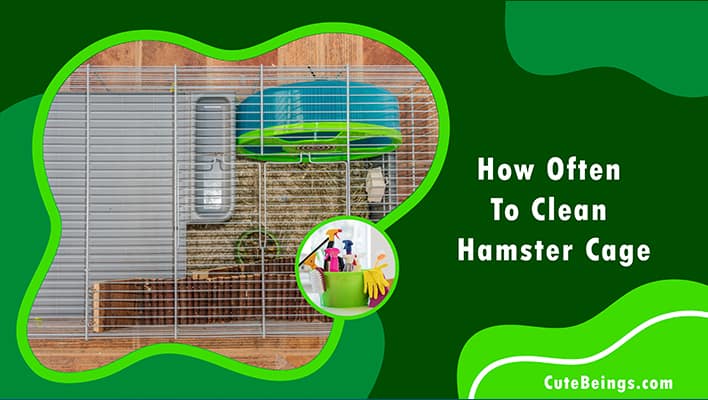Hey there, hamster parents! Are you wondering how often you need to clean your pet’s cage? Well, I’m here to help. Keeping a clean and safe environment for your furry friend is essential to their health and happiness. In this article, I’ll be going over the basics of cleaning a hamster cage; when should it get done, what materials are needed, and more. So let’s dive in!
No matter which type of hamster you have – Syrian or dwarf keeping their living space tidy will definitely benefit them. But just how often do we need to make sure that the cage gets cleaned? Well, that depends on several factors, such as the size of your pet, their eating habits, and other lifestyle choices like exercise frequency.
Table of Contents
So How Often To Clean Hamster Cage
The answer depends on the type of hamster you have: Syrian or dwarf.
For Syrians, their cages will need regular attention at least once a week. This means removing all old bedding and straws, replacing them with fresh ones and giving those tunnels and hideouts a thorough scrub down. But don’t worry if this seems daunting—there are plenty of tips to make sure these tasks stay easy! With some proper maintenance, your little friend can enjoy its home in no time.
How Often To Clean Food And Water Dispensers
Now that we have discussed how often to clean a hamster cage, let’s move on to cleaning the food and water dispensers. It is essential for Syrian hamsters’ health to keep their food and water bowls clean at all times. This means you should be changing out their food and water daily. If your hamster’s cages feature food or water dispensers, they will need to be cleaned once a week with soap and warm water. Make sure these are thoroughly rinsed before refilling them with fresh supplies of food and water. Doing this regularly ensures your furry friend has access to safe, hygienic resources throughout its lifetime.
How Often To Change The Hamster Bedding
To truly enjoy your furry friend, it’s essential to create a comfortable home for them. A critical part of that is making sure you change their bedding regularly. So, how often should one change the hamster bedding?
First things first, let’s start with understanding what kind of bedding works best for your pet. Many people opt for wood shavings or paper-based products as they are biodegradable and work well in absorbing any liquid wastes from your pet. But whatever type of material you choose, be sure to check if there are dust particles present before adding it into the cage – this can pose health risks to your little pal!
Now onto frequency – when it comes to changing out bedding, experts recommend doing so every week or two at most. Of course, this depends on certain factors such as whether you clean out their tunnels and hideouts frequently too; but generally speaking, make sure not to go over two weeks without replacing any old materials with fresh ones. This will ensure both comfort and hygiene levels remain high within their living space.
How Often Clean Hamster Tunnels And Hideouts
Now that we have talked about how often to change the hamster bedding, let’s talk about cleaning the tunnels and hideouts. This is an important part of keeping your Syrian hamster healthy and happy.
It is recommended to clean out your hamsters tunnels and hideouts at least once a week. You can use a damp cloth or paper towel with warm water to wipe down the inside of their tunnel and any toys they may have in there. Make sure you rinse off all soap residue before replacing them back into their cages. Cleaning out these items more often than once per week is also beneficial for your pet’s health as it helps remove dirt and debris from their living environment.
Hamsters love exploring different objects in their cage so it’s important to make sure you are regularly cleaning the tunnels and hideouts often to prevent buildup of bacteria or parasites which could be harmful to your pet’s health.
How Long Can A Hamster Go Without A Clean Cage?
This depends on several factors such as the size and type of cage, number of animals, and substrate used in the habitat. Generally speaking, you should not let more than two weeks pass before giving your hamster’s home a thorough cleaning. During this time period, spot-cleaning should be done to remove any messes or droppings left behind by your pet. Spot-cleaning also helps keep odors at bay while ensuring that your furry friend has enough space to move around freely in their enclosure.
By paying attention to these details, you can ensure that your pet lives in a safe and healthy environment and avoid potential health risks associated with unclean cages.
Conclusion
Cleaning your hamster cage is an important part of keeping them healthy and happy. It can be hard to keep up with the regular cleaning schedule, but it’s necessary for their well-being. I understand that you may feel overwhelmed or busy, and don’t want to add anything else onto your plate. But trust me when I say it doesn’t have to take up too much time!
Cleaning out food and water dispensers only needs to be done every few days, while bedding should be replaced once a week. Hamster tunnels and hideouts need less frequent attention – clean these at least every month or two. Even if you miss a day here and there, Syrian hamsters are able to go a couple of days without being cleaned out as long as they have fresh food, water and bedding available. So make sure to include some ‘hammy care’ in your weekly routine – it will pay off in the end!
Frequently Asked Questions (FAQ)
How Often Should You Clean A Syrian Hamster Cage
It’s recommended that owners clean their Syrian hamster cages at least once per week. To illustrate just how important this task can be for your pet’s health, consider this: if you leave a dirty cage alone for too long, bacteria and parasites can breed quickly. This could cause illness or infection in your beloved companion. Keeping up with regular cleanings helps prevent these potential problems from cropping up!
Of course, some weeks may require more attention than others. If there are small messes that appear between weekly cleanings (for example, uneaten food or spilled water), make sure to take care of those as soon as possible. That way, everything stays sanitary and comfortable for your hamster pal!

Hello, my name is James and I’ve been caring for tiny pets for over 14 years with a passion. I enjoy passing on my expertise to other individuals in order for them to have the same amount of enjoyment as I do.




